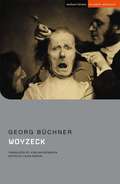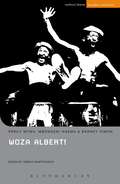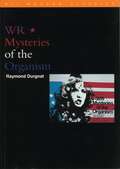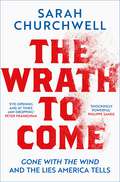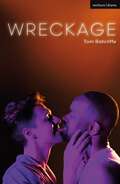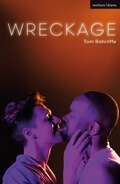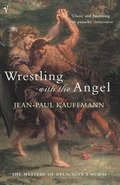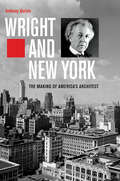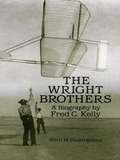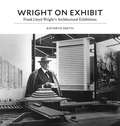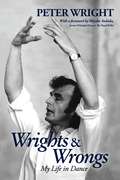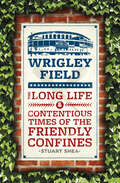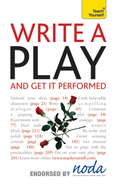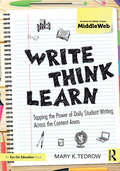- Table View
- List View
Woyzeck (Student Editions)
by Georg BüchnerWritten in 1836, Woyzeck is often considered to be the first truly modern play.The story of a soldier driven mad by inhuman military discipline and acute social deprivation is told in splintered dialogue and jagged episodes, which are as shocking and telling today as they were when first performed, almost a century after the author's death, in Munich 1913.This edition contains introductory commentary and notes by Laura Martin from the University of Glasgow. METHUEN DRAMA STUDENT EDITIONS are expertly annotated texts of a wide range of plays from the modern and classic repertoires. A well as the complete text of the play itself, this volume contains:· A chronology of the play and the playwright's life and work· an introductory discussion of the social, political, cultural and economic context in which the play was originally conceived and created· a succinct overview of the creation processes followed and subsequent performance history of the piece· an analysis of, and commentary on, some of the major themes and specific issues addressed by the text· a bibliography of suggested primary and secondary materials for further study.
Woza Albert! (Student Editions)
by Percy Mtwa Mbongeni Ngema Barney Simon Temple HauptfleischWoza Albert! is one of the most popular and influential plays to have come out of the South African cultural struggle of the 1980s and a central work in the canon of South African theatre. Working with the idea of the Second Coming of Jesus Christ taking place in apartheid South Africa, the playwrights improvised a brilliant two-man show consisting of 26 vignettes, commenting on and satirising life under the apartheid regime. The play has become one of the most anthologized and produced South African plays both in South Africa, and internationally and is studied widely in schools as well as universities. This Student Edition contains a commentary and notes by Temple Hauptfleisch, Emeritus Professor at Stellenbosch University, South Africa. METHUEN DRAMA STUDENT EDITIONS are expertly annotated texts of a wide range of plays from the modern and classic repertoires. A well as the complete text of the play itself, this volume contains: · A contextualised chronology of the play and the playwrights' lives and works· an introductory discussion of the social, political, cultural and economic context in which the play was originally conceived and created· a succinct overview of the creation processes followed and subsequent performance history of the piece· an analysis of, and commentary on, some of the major themes and specific issues addressed by the text· a bibliography of suggested primary and secondary materials.
Woza Albert!: A Study Guide (Student Editions)
by Percy Mtwa Mbongeni Ngema Barney Simon Temple HauptfleischWoza Albert! is one of the most popular and influential plays to have come out of the South African cultural struggle of the 1980s and a central work in the canon of South African theatre. Working with the idea of the Second Coming of Jesus Christ taking place in apartheid South Africa, the playwrights improvised a brilliant two-man show consisting of 26 vignettes, commenting on and satirising life under the apartheid regime. The play has become one of the most anthologized and produced South African plays both in South Africa, and internationally and is studied widely in schools as well as universities. This Student Edition contains a commentary and notes by Temple Hauptfleisch, Emeritus Professor at Stellenbosch University, South Africa. METHUEN DRAMA STUDENT EDITIONS are expertly annotated texts of a wide range of plays from the modern and classic repertoires. A well as the complete text of the play itself, this volume contains: · A contextualised chronology of the play and the playwrights' lives and works· an introductory discussion of the social, political, cultural and economic context in which the play was originally conceived and created· a succinct overview of the creation processes followed and subsequent performance history of the piece· an analysis of, and commentary on, some of the major themes and specific issues addressed by the text· a bibliography of suggested primary and secondary materials.
WR: Mysteries of the Organism (BFI Film Classics)
by Raymond DurgnatIn Dusan Makavejev's controversial and explicit WR - Mysteries of the Organism (1971), 'WR' is Wilhelm Reich, the Marxist psychoanalyst who preached sexual enlightenment as a gateway to a better society. Reich is a 'intellectual maverick' and 'sexual pioneer', and theorist of 'Orgone energy' and 'world revolution'. Loosely inspired by Reich's 'The Function of the Orgasm' WR stages an encounter between psychotherapy and Marxism, sexual permissiveness and socialism. Juxtaposing hippie America and cold war Yugoslavia, it is a film of ideas and sensations which speaks to the contemporary world. It was banned in Yugoslavia, under pressure from Moscow, as politically offensive. This book explores the film and how its spectators interact with it.
WR: Mysteries of the Organism (BFI Film Classics)
by Raymond DurgnatIn Dusan Makavejev's controversial and explicit WR - Mysteries of the Organism (1971), 'WR' is Wilhelm Reich, the Marxist psychoanalyst who preached sexual enlightenment as a gateway to a better society. Reich is a 'intellectual maverick' and 'sexual pioneer', and theorist of 'Orgone energy' and 'world revolution'. Loosely inspired by Reich's 'The Function of the Orgasm' WR stages an encounter between psychotherapy and Marxism, sexual permissiveness and socialism. Juxtaposing hippie America and cold war Yugoslavia, it is a film of ideas and sensations which speaks to the contemporary world. It was banned in Yugoslavia, under pressure from Moscow, as politically offensive. This book explores the film and how its spectators interact with it.
The Wrath to Come: Gone with the Wind and the Lies America Tells
by Sarah ChurchwellThe history America never wanted you to read. 'The narrative took my breath away' Philippe Sands 'An extraordinarily and shockingly powerful read' Peter Frankopan 'One of the must-reads of the year' Suzannah Lipscomb 'Brilliant and provocative' Gavin EslerSarah Churchwell examines one of the most enduringly popular stories of all time, Gone with the Wind, to help explain the divisions ripping the United States apart today. Separating fact from fiction, she shows how histories of mythmaking have informed America's racial and gender politics, the controversies over Confederate statues, the resurgence of white nationalism, the Black Lives Matter movement, the enduring power of the American Dream, and the violence of Trumpism.Gone with the Wind was an instant bestseller when it was published in 1936; its film version became the most successful Hollywood film of all time. Today the story's racism is again a subject of controversy, but it was just as controversial in the 1930s, foreshadowing today's debates over race and American fascism. In The Wrath to Come, Sarah Churchwell charts an extraordinary journey through 160 years of American denialism. From the Lost Cause to the romances behind the Ku Klux Klan, from the invention of the 'ideal' slave plantation to the erasure of interwar fascism, Churchwell shows what happens when we do violence to history, as collective denial turns fictions into lies, and lies into a vicious reality.
Wreckage (Modern Plays)
by Tom RatcliffeI love you I love you I love you I love you I love you.Sam and his fiancé Noel have been together for years. They have a house, a cat and their whole lives ahead of them. But when a sudden and permanent distance crashes into their relationship, it falls upon Sam to discover where their story goes from here. Tom Ratcliffe's Wreckage is a touching story about continuing bonds and love that only evolves, and never dies. This edition was published to coincide with the run at Edinburgh Festival Fringe 2022 and subsequent UK tour.
Wreckage (Modern Plays)
by Tom RatcliffeI love you I love you I love you I love you I love you.Sam and his fiancé Noel have been together for years. They have a house, a cat and their whole lives ahead of them. But when a sudden and permanent distance crashes into their relationship, it falls upon Sam to discover where their story goes from here. Tom Ratcliffe's Wreckage is a touching story about continuing bonds and love that only evolves, and never dies. This edition was published to coincide with the run at Edinburgh Festival Fringe 2022 and subsequent UK tour.
Wren’s Burford Masons: Unsung Heroes of 17th and Early 18th Century English Architecture (Routledge Research in Architecture)
by Melody MobusThis book shows, for the first time, the indispensable role of the Burford Masons, a group of master masons from the historic quarries around Burford, Oxfordshire, in creating some of the foremost buildings of the 17th and early 18th centuries. The Burford Masons were involved in the construction of such outstanding buildings as St Paul's Cathedral, City churches, and Blenheim Palace, among many others. Whilst credit for many of these buildings generally rests with named architects, Sir Christopher Wren in particular, this book shows how reliant these designers were on their master craftsmen, sometimes involving them in the design process as their ideas evolved. The book further shows how the Burford Masons responded to the challenge of late payments, often of many years, becoming financiers in the process. It reveals how, as risk-taking businessmen, they effectively underpinned both public and private development financially, and how extraordinary success transformed their lives. The reader will learn about the vital part played in the early modern period by master craftsmen of the calibre of the Burford Masons, despite the emergence of the architect as lead designer, whose fame has hitherto overshadowed them. As a result, this book will be a compelling read for anyone interested in architectural, construction or social history.
Wren’s Burford Masons: Unsung Heroes of 17th and Early 18th Century English Architecture (Routledge Research in Architecture)
by Melody MobusThis book shows, for the first time, the indispensable role of the Burford Masons, a group of master masons from the historic quarries around Burford, Oxfordshire, in creating some of the foremost buildings of the 17th and early 18th centuries. The Burford Masons were involved in the construction of such outstanding buildings as St Paul's Cathedral, City churches, and Blenheim Palace, among many others. Whilst credit for many of these buildings generally rests with named architects, Sir Christopher Wren in particular, this book shows how reliant these designers were on their master craftsmen, sometimes involving them in the design process as their ideas evolved. The book further shows how the Burford Masons responded to the challenge of late payments, often of many years, becoming financiers in the process. It reveals how, as risk-taking businessmen, they effectively underpinned both public and private development financially, and how extraordinary success transformed their lives. The reader will learn about the vital part played in the early modern period by master craftsmen of the calibre of the Burford Masons, despite the emergence of the architect as lead designer, whose fame has hitherto overshadowed them. As a result, this book will be a compelling read for anyone interested in architectural, construction or social history.
Wrestling With The Angel: The Mystery Of Delacroix's Mural
by Jean-Paul KauffmannNear the end of his life, the great Romantic artist Eug-ne Delacroix (1798-1863) painted one of the most enigmatic episodes from the Bible: Jacob wrestling with the angel. This painting, which decorates the wall of the Chapel of the Holy Angels in the Paris church of Saint-Sulpice, is Delacroix's "spiritual testament". But Sain-Sulpice is a mysterious church where everything happens behind the scenes. A fan of Inspector Maigret, Jean-Paul Kauffmann investigates the painting and the church, paying particular attention to its hidden history. He searches for clues in a bar in Dieppe, a castle in Quercy, a village in the Argonne, an oak tree in the forest at S-nart, even a golf course in the Loiret. The trail leads him to an art critic, a lecturer at the Louvre, and a sculptor who has a studio in the attic of Saint-Sulpice itself. All these intertwining threads finally come together in a central motif in which Kauffmann himself is involved. There comes a time in which everyone must wrestle with the angel.
Wright and New York: The Making of America's Architect
by Anthony AlofsinA dazzling dual portrait of Frank Lloyd Wright and early twentieth-century New York, revealing the city’s role in establishing the career of America’s most famous architect Frank Lloyd Wright (1867–1959) took his first major trip to New York in 1909, fleeing a failed marriage and artistic stagnation. He returned a decade later, his personal life and architectural career again in crisis. Booming 1920s New York served as a refuge, but it also challenged him and resurrected his career. The city connected Wright with important clients and commissions that would harness his creative energy and define his role in modern architecture, even as the stock market crash took its toll on his benefactors. Wright denounced New York as an “unlivable prison” even as he reveled in its culture. The city became an urban foil for Wright’s work in the desert and in the “organic architecture” he promoted as an alternative to American Art Deco and the International Style. New York became a major protagonist at the end of Wright’s life, as he spent his final years at the Plaza Hotel working on the Guggenheim Museum, the building that would cement his legacy. Anthony Alofsin has broken new ground by mining the recently opened Wright archives held by Columbia University and the Museum of Modern Art. His foundational research provides a crucial and innovative understanding of Wright’s life, his career, and the conditions that enabled his success. The result is at once a stunning biography and a glittering portrait of early twentieth-century Manhattan.
The Wright Brothers: A Biography
by Fred C. KellyIn this fascinating, highly readable biography, Fred C. Kelly, a former newspaperman, author, and an old friend of the Wrights, tells the story of the two brilliant, dedicated, flight-obsessed bicycle mechanics from Ohio who first realized mankind's age-old dream of conquering the skies. Long considered the definitive Wright biography (the manuscript was read and approved by Orville Wright), this book recounts the Wrights' small-town boyhood, their early interest in all things mechanical, the establishment of the Wright Cycle Shop, and the complete behind-the-scenes story of how they designed, built, tested, and flew (December 1903) the first "Flyer."Enhanced with sixteen rare photographs, Mr. Kelly's engaging account avoids minute technical description, yet describes simply and clearly the technological innovations that enabled the two brothers to succeed where so many others had failed. Anyone interested in the mechanics of flight or early aviation will find this volume a splendid introduction to the Wright brothers and their epochal achievement.
Wright on Exhibit: Frank Lloyd Wright's Architectural Exhibitions
by Kathryn SmithThe first history of Frank Lloyd Wright's exhibitions of his own work—a practice central to his careerMore than one hundred exhibitions of Frank Lloyd Wright's work were mounted between 1894 and his death in 1959. Wright organized the majority of these exhibitions himself and viewed them as crucial to his self-presentation as his extensive writings. He used them to promote his designs, appeal to new viewers, and persuade his detractors. Wright on Exhibit presents the first history of this neglected aspect of the architect’s influential career. Drawing extensively from Wright’s unpublished correspondence, Kathryn Smith challenges the preconceived notion of Wright as a self-promoter who displayed his work in search of money, clients, and fame. She shows how he was an artist-architect projecting an avant-garde program, an innovator who expanded the palette of installation design as technology evolved, and a social activist driven to revolutionize society through design. While Wright’s earliest exhibitions were largely for other architects, by the 1930s he was creating public installations intended to inspire debate and change public perceptions about architecture. The nature of his exhibitions expanded with the times beyond models, drawings, and photographs to include more immersive tools such as slides, film, and even a full-scale structure built especially for his 1953 retrospective at the Guggenheim Museum. Placing Wright’s exhibitions side by side with his writings, Smith shows how integral these exhibitions were to his vision and sheds light on the broader discourse concerning architecture and modernism during the first half of the twentieth century. Wright on Exhibit features color renderings, photos, and plans, as well as a checklist of exhibitions and an illustrated catalog of extant and lost models made under Wright’s supervision.
Wright on Exhibit: Frank Lloyd Wright's Architectural Exhibitions
by Kathryn SmithThe first history of Frank Lloyd Wright's exhibitions of his own work—a practice central to his careerMore than one hundred exhibitions of Frank Lloyd Wright's work were mounted between 1894 and his death in 1959. Wright organized the majority of these exhibitions himself and viewed them as crucial to his self-presentation as his extensive writings. He used them to promote his designs, appeal to new viewers, and persuade his detractors. Wright on Exhibit presents the first history of this neglected aspect of the architect’s influential career. Drawing extensively from Wright’s unpublished correspondence, Kathryn Smith challenges the preconceived notion of Wright as a self-promoter who displayed his work in search of money, clients, and fame. She shows how he was an artist-architect projecting an avant-garde program, an innovator who expanded the palette of installation design as technology evolved, and a social activist driven to revolutionize society through design. While Wright’s earliest exhibitions were largely for other architects, by the 1930s he was creating public installations intended to inspire debate and change public perceptions about architecture. The nature of his exhibitions expanded with the times beyond models, drawings, and photographs to include more immersive tools such as slides, film, and even a full-scale structure built especially for his 1953 retrospective at the Guggenheim Museum. Placing Wright’s exhibitions side by side with his writings, Smith shows how integral these exhibitions were to his vision and sheds light on the broader discourse concerning architecture and modernism during the first half of the twentieth century. Wright on Exhibit features color renderings, photos, and plans, as well as a checklist of exhibitions and an illustrated catalog of extant and lost models made under Wright’s supervision.
Wright on Exhibit: Frank Lloyd Wright's Architectural Exhibitions
by Kathryn SmithThe first history of Frank Lloyd Wright's exhibitions of his own work—a practice central to his careerMore than one hundred exhibitions of Frank Lloyd Wright's work were mounted between 1894 and his death in 1959. Wright organized the majority of these exhibitions himself and viewed them as crucial to his self-presentation as his extensive writings. He used them to promote his designs, appeal to new viewers, and persuade his detractors. Wright on Exhibit presents the first history of this neglected aspect of the architect’s influential career. Drawing extensively from Wright’s unpublished correspondence, Kathryn Smith challenges the preconceived notion of Wright as a self-promoter who displayed his work in search of money, clients, and fame. She shows how he was an artist-architect projecting an avant-garde program, an innovator who expanded the palette of installation design as technology evolved, and a social activist driven to revolutionize society through design. While Wright’s earliest exhibitions were largely for other architects, by the 1930s he was creating public installations intended to inspire debate and change public perceptions about architecture. The nature of his exhibitions expanded with the times beyond models, drawings, and photographs to include more immersive tools such as slides, film, and even a full-scale structure built especially for his 1953 retrospective at the Guggenheim Museum. Placing Wright’s exhibitions side by side with his writings, Smith shows how integral these exhibitions were to his vision and sheds light on the broader discourse concerning architecture and modernism during the first half of the twentieth century. Wright on Exhibit features color renderings, photos, and plans, as well as a checklist of exhibitions and an illustrated catalog of extant and lost models made under Wright’s supervision.
Wright on Exhibit: Frank Lloyd Wright's Architectural Exhibitions
by Kathryn SmithThe first history of Frank Lloyd Wright's exhibitions of his own work—a practice central to his careerMore than one hundred exhibitions of Frank Lloyd Wright's work were mounted between 1894 and his death in 1959. Wright organized the majority of these exhibitions himself and viewed them as crucial to his self-presentation as his extensive writings. He used them to promote his designs, appeal to new viewers, and persuade his detractors. Wright on Exhibit presents the first history of this neglected aspect of the architect’s influential career.Drawing extensively from Wright’s unpublished correspondence, Kathryn Smith challenges the preconceived notion of Wright as a self-promoter who displayed his work in search of money, clients, and fame. She shows how he was an artist-architect projecting an avant-garde program, an innovator who expanded the palette of installation design as technology evolved, and a social activist driven to revolutionize society through design. While Wright’s earliest exhibitions were largely for other architects, by the 1930s he was creating public installations intended to inspire debate and change public perceptions about architecture. The nature of his exhibitions expanded with the times beyond models, drawings, and photographs to include more immersive tools such as slides, film, and even a full-scale structure built especially for his 1953 retrospective at the Guggenheim Museum. Placing Wright’s exhibitions side by side with his writings, Smith shows how integral these exhibitions were to his vision and sheds light on the broader discourse concerning architecture and modernism during the first half of the twentieth century.Wright on Exhibit features color renderings, photos, and plans, as well as a checklist of exhibitions and an illustrated catalog of extant and lost models made under Wright’s supervision.
Wrights & Wrongs: My Life In Dance
by Peter Wright Paul ArrowsmithPeter Wright has been a dancer, choreographer, teacher, producer and director in the theatre as well as in television for over 70 years. His many productions of classic ballets are danced by companies not only in Britain but North and South America, Australia and Japan as well as in Europe. His production of Giselle has been danced by National Ballet of Canada for over 40 years. Birmingham Royal Ballet, the company he created, has performed his Swan Lake for 35 years, The Sleeping Beauty for over 30, a production Peter staged in Budapest in April 2016. His different stagings of The Nutcracker at Covent Garden and in Birmingham have charmed audiences for over 30 years. Peter started his career in wartime, with the Kurt Jooss company. He has worked with such greats as Pina Bausch, Margot Fonteyn, Rudolf Nureyev, Marcia Haydée, Richard Cragun, Monica Mason, Karen Kain, Miyako Yoshida and Carlos Acosta – as well as today’s generation of stars including Alina Cojocaru, Marianela Nuñez, Natalia Osipova and Lauren Cuthbertson. While now regarded as part of the British ballet establishment, for many years Peter developed his career outside London, particularly in Germany with John Cranko’s Stuttgart Ballet. That distance gives him a unique and unrivalled view on ballet companies. His close association with choreographers Frederick Ashton, Ninette de Valois, founder of the Royal Ballet, Kenneth MacMillan and David Bintley gives Peter an authoritative perspective on British ballet. In Wrights & Wrongs, Peter offers his often surprising views of today’s dance world, lessons learned – and yet to learn – from a lifetime’s experience of ballet, commercial theatre and television.
Wrigley Field: The Long Life and Contentious Times of the Friendly Confines
by Stuart SheaIn spring 1914, a new ballpark opened in Chicago. Hastily constructed after epic political maneuvering around Chicago’s and organized baseball’s hierarchies, the new Weeghman Park (named after its builder, fast-food magnate Charley Weeghman) was home to the Federal League’s Chicago Whales. The park would soon be known as Wrigley Field, one of the most emblematic and controversial baseball stadiums in America. In Wrigley Field: The Long Life and Contentious Times of the Friendly Confines, Stuart Shea provides a detailed and fascinating chronicle of this living historic landmark. The colorful history revealed in Wrigley Field shows how the stadium has evolved through the years to meet the shifting priorities of its owners and changing demands of its fans. While Wrigley Field today seems irreplaceable, we learn that from game one it has been the subject of endless debates over its future, its design, and its place in the neighborhood it calls home. To some, it is a hallowed piece of baseball history; to others, an icon of mismanagement and ineptitude. Shea deftly navigates the highs and lows, breaking through myths and rumors. And with another transformation imminent, he brings readers up to date on negotiations, giving much-needed historical context to the maneuvering. Wrigley Field is packed with facts, stories, and surprises that will captivate even the most fair-weather fan. From dollar signs (the Ricketts family paid $900 million for the team and stadium in 2009), to exploding hot dog carts (the Cubs lost that game 6–5), to the name of Billy Sianis’s curse-inducing goat (Sonovia), Shea uncovers the heart of the stadium’s history. As the park celebrates its centennial, Wrigley Field continues to prove that its colorful and dramatic history is more interesting than any of its mythology.
Wrigley Field: The Long Life and Contentious Times of the Friendly Confines
by Stuart SheaIn spring 1914, a new ballpark opened in Chicago. Hastily constructed after epic political maneuvering around Chicago’s and organized baseball’s hierarchies, the new Weeghman Park (named after its builder, fast-food magnate Charley Weeghman) was home to the Federal League’s Chicago Whales. The park would soon be known as Wrigley Field, one of the most emblematic and controversial baseball stadiums in America. In Wrigley Field: The Long Life and Contentious Times of the Friendly Confines, Stuart Shea provides a detailed and fascinating chronicle of this living historic landmark. The colorful history revealed in Wrigley Field shows how the stadium has evolved through the years to meet the shifting priorities of its owners and changing demands of its fans. While Wrigley Field today seems irreplaceable, we learn that from game one it has been the subject of endless debates over its future, its design, and its place in the neighborhood it calls home. To some, it is a hallowed piece of baseball history; to others, an icon of mismanagement and ineptitude. Shea deftly navigates the highs and lows, breaking through myths and rumors. And with another transformation imminent, he brings readers up to date on negotiations, giving much-needed historical context to the maneuvering. Wrigley Field is packed with facts, stories, and surprises that will captivate even the most fair-weather fan. From dollar signs (the Ricketts family paid $900 million for the team and stadium in 2009), to exploding hot dog carts (the Cubs lost that game 6–5), to the name of Billy Sianis’s curse-inducing goat (Sonovia), Shea uncovers the heart of the stadium’s history. As the park celebrates its centennial, Wrigley Field continues to prove that its colorful and dramatic history is more interesting than any of its mythology.
Wrigley Field: The Long Life and Contentious Times of the Friendly Confines
by Stuart SheaIn spring 1914, a new ballpark opened in Chicago. Hastily constructed after epic political maneuvering around Chicago’s and organized baseball’s hierarchies, the new Weeghman Park (named after its builder, fast-food magnate Charley Weeghman) was home to the Federal League’s Chicago Whales. The park would soon be known as Wrigley Field, one of the most emblematic and controversial baseball stadiums in America. In Wrigley Field: The Long Life and Contentious Times of the Friendly Confines, Stuart Shea provides a detailed and fascinating chronicle of this living historic landmark. The colorful history revealed in Wrigley Field shows how the stadium has evolved through the years to meet the shifting priorities of its owners and changing demands of its fans. While Wrigley Field today seems irreplaceable, we learn that from game one it has been the subject of endless debates over its future, its design, and its place in the neighborhood it calls home. To some, it is a hallowed piece of baseball history; to others, an icon of mismanagement and ineptitude. Shea deftly navigates the highs and lows, breaking through myths and rumors. And with another transformation imminent, he brings readers up to date on negotiations, giving much-needed historical context to the maneuvering. Wrigley Field is packed with facts, stories, and surprises that will captivate even the most fair-weather fan. From dollar signs (the Ricketts family paid $900 million for the team and stadium in 2009), to exploding hot dog carts (the Cubs lost that game 6–5), to the name of Billy Sianis’s curse-inducing goat (Sonovia), Shea uncovers the heart of the stadium’s history. As the park celebrates its centennial, Wrigley Field continues to prove that its colorful and dramatic history is more interesting than any of its mythology.
Wrigley Field: The Long Life and Contentious Times of the Friendly Confines
by Stuart SheaIn spring 1914, a new ballpark opened in Chicago. Hastily constructed after epic political maneuvering around Chicago’s and organized baseball’s hierarchies, the new Weeghman Park (named after its builder, fast-food magnate Charley Weeghman) was home to the Federal League’s Chicago Whales. The park would soon be known as Wrigley Field, one of the most emblematic and controversial baseball stadiums in America. In Wrigley Field: The Long Life and Contentious Times of the Friendly Confines, Stuart Shea provides a detailed and fascinating chronicle of this living historic landmark. The colorful history revealed in Wrigley Field shows how the stadium has evolved through the years to meet the shifting priorities of its owners and changing demands of its fans. While Wrigley Field today seems irreplaceable, we learn that from game one it has been the subject of endless debates over its future, its design, and its place in the neighborhood it calls home. To some, it is a hallowed piece of baseball history; to others, an icon of mismanagement and ineptitude. Shea deftly navigates the highs and lows, breaking through myths and rumors. And with another transformation imminent, he brings readers up to date on negotiations, giving much-needed historical context to the maneuvering. Wrigley Field is packed with facts, stories, and surprises that will captivate even the most fair-weather fan. From dollar signs (the Ricketts family paid $900 million for the team and stadium in 2009), to exploding hot dog carts (the Cubs lost that game 6–5), to the name of Billy Sianis’s curse-inducing goat (Sonovia), Shea uncovers the heart of the stadium’s history. As the park celebrates its centennial, Wrigley Field continues to prove that its colorful and dramatic history is more interesting than any of its mythology.
Write A Play And Get It Performed: Teach Yourself (Teach Yourself)
by Lesley Bown Ann GawthorpeWrite a Play - and Get It Performed is designed for would-be writers of every level and for all types of motivation by two prize-winning professionals. Whether writing for the specific needs of an amateur drama group, community event, political campaign or simply for personal or professional development, this is a guide to the craft of playwriting. It offers guidance on the creative principles of scripts, characters, plot, structure and dialogue and explains the principles of staging and stage directions as well as gives tips on how to write for a variety of different situations, for every age and ability and according to specific genres - particularly those often preferred by amateur groups, such as pantomime and musical theatre.NOT GOT MUCH TIME?One, five and ten-minute introductions to key principles to get you started.AUTHOR INSIGHTSLots of instant help with common problems and quick tips for success, based on the author's many years of experience.TEST YOURSELFTests in the book and online to keep track of your progress.EXTEND YOUR KNOWLEDGEExtra online articles at www.teachyourself.com to give you a richer understanding of writing a play.FIVE THINGS TO REMEMBERQuick refreshers to help you remember the key facts.TRY THISInnovative exercises illustrate what you've learnt and how to use it.
Write, Think, Learn: Tapping the Power of Daily Student Writing Across the Content Areas
by Mary K. TedrowFind out how to create the climate and space for everyday student writing. In this new co-publication with MiddleWeb, award-winning teacher Mary Tedrow shows you how to encourage students to integrate daily writing into their lives, leading to improved critical thinking skills, increased knowledge of subject areas, and greater confidence in written expression. This practical guide will help you consider the unique needs of your students, while still meeting state standards. You’ll discover how to… Develop classroom routines and activities that invite creativity and self-expression Teach writing methods that can be used across different grade levels and all content areas Challenge students to examine their own writing processes for thinking and problem solving Evaluate written work in a way that emphasizes growth over grades Many exercises, prompts, and attempts at thinking found in the book can be easily adapted for use both in and out of the classroom. Whether you are a new or experienced teacher, Write, Think, Learn will enable you to make writing come alive for all your students.
Write, Think, Learn: Tapping the Power of Daily Student Writing Across the Content Areas
by Mary K. TedrowFind out how to create the climate and space for everyday student writing. In this new co-publication with MiddleWeb, award-winning teacher Mary Tedrow shows you how to encourage students to integrate daily writing into their lives, leading to improved critical thinking skills, increased knowledge of subject areas, and greater confidence in written expression. This practical guide will help you consider the unique needs of your students, while still meeting state standards. You’ll discover how to… Develop classroom routines and activities that invite creativity and self-expression Teach writing methods that can be used across different grade levels and all content areas Challenge students to examine their own writing processes for thinking and problem solving Evaluate written work in a way that emphasizes growth over grades Many exercises, prompts, and attempts at thinking found in the book can be easily adapted for use both in and out of the classroom. Whether you are a new or experienced teacher, Write, Think, Learn will enable you to make writing come alive for all your students.
